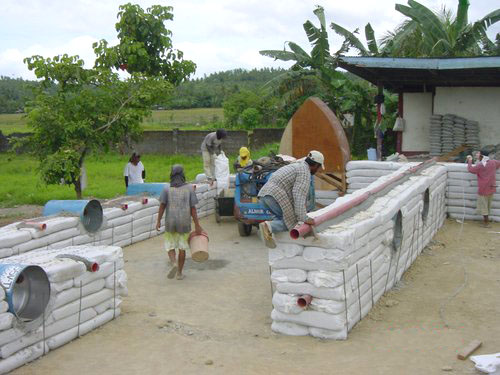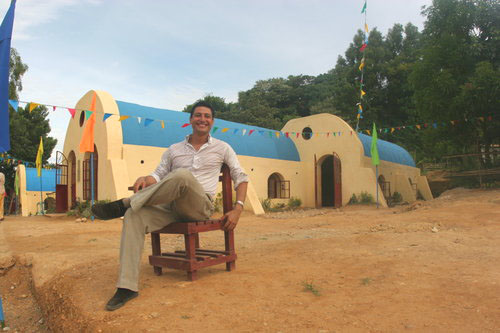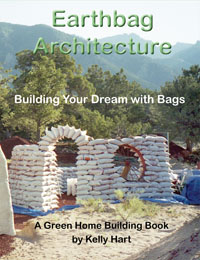| Earthbag School in the Philippines |
EACH day of school, 273 students of Day-asan National High School in Surigao in the Philippines hold classes in two classrooms. There is a makeshift hut made of nipa and, beside it, a room that doubles as the barangay's multipurpose hall. Despite the school's effort to make do with what is available, the students still find it difficult to learn because of the noise and overcrowding. With the rainy season ushering in typhoons and strong winds, this becomes an even bigger concern for Day-asan residents. This scenario is hardly new in Philippine schools. Problems in the education sector have dramatically increased in the past few years, with the lack of classrooms growing by a whopping 586 percent from 8,443 in schoolyear 2001-2002 to 57,930 in schoolyear 2005-2006. Lack of seats also increased 65 percent from 2.11 million to 3.48 million. The shortage of classrooms has prompted concerned organizations to take matters into their own hands and enforce real solutions to the serious problem. The Akayin ang Bukluran ng Kabataan sa Daigdig (Abakada) Inc. and its partner, My Shelter Foundation Inc., decided to bring newfound hope and a renewed sense of independence to the residents and students of Barangay Day-asan through the pioneering Earthbag School Project. When a country has a huge shortage of classrooms-like the Philippines lacking 74,115-the obvious solution would be the construction of more classrooms. In areas where resources are hard to come by, however, that solution is easier said than done. Some stakeholders in this city chose to do something about the problem, leading to the inauguration of six cost-efficient classrooms in Barangay Day-Asan. The Earthbag Technology System is a method for housing that uses onsite earth as its main building component, with very minimal use of wood, steel and skilled labor. It costs 40 percent less than conventional classrooms and may be put up in a short time. For this project, five classrooms and one room to be used as a resource center with alternative construction were built to make for a better learning experience, encourage community participation and empower local residents to be self-sufficient. It started when the World Bank organized a competition called "Panibagong Paraan" (New Ways). An NGO submitted the proposal for "Ibang Klase: Earthbag Classrooms" (One-of-A-Kind: Earthbag Classrooms) that will use this technology. Abakada's proposal won a P1 million grant from the Japanese embassy. The NGO approached several congressmen to get the project rolling. Robert Ace Barbers (newly elected governor) donated to the project the proceeds of the golf tournament that he organizes annually. In time, the Surigao City government helped as well by loaning heavy equipment for the construction of the classrooms. Abakada tapped social entrepreneur Illac Diaz of My Shelter Foundation to do the structural design of the classrooms. Diaz said that from the standard cost of constructing a classroom, which ranged from P400,000 to P500,000, the earthbag system cut down the cost to about P200,000 per classroom. Before, classrooms in Day-Asan National High School were made mainly of nipa. Students had to struggle with the noise from classes being held at the nearby barangay multi-purpose hall. With the completion of the Abakada project, the school now has 10 classrooms and a library that can cater to the needs of 360 students. This convinced Abakada executive director Crisel Cudiamat that there is a "need to be open to other modes of construction." Its unique design and earth material makes it self-cooling and equally durable compared to regular or standard classroom construction. Illac Diaz, founder of My Shelter Foundation, Inc. and one of 2008's Young Global Leaders recognized by the World Economic Forum, believes rebuilding and helping communities hit by calamities is "about empowerment and using the energies of the people who are the target beneficiaries as the greatest force for their own uplifting." He believes empowering the community involves creates "a system of sustainability and replication ability." Diaz says, "The impact of climate change will always be the worst on the poor-the people least able to protect themselves. And when a natural disaster strikes in the developing world, the principal place of refuge in poor communities is often the local school. So my thought was, by designing school buildings to be more disaster-resistant, we can mitigate the damage and loss of life caused by the growing number of typhoons. This is how the Millennium Schools Design Competition was born." "In addition to the basic requirements for making the building less expensive and more typhoon-resistant, we also wanted to come up with a design that would be more conducive to teaching and learning than the dark and hot box layout typically used in that part of the world. How could we provide better ventilation? How could we increase the amount of natural light inside the building without making it hotter?" Diaz was the one who tapped cement giant La Farge Semento to provide technical assistance in the construction of the classrooms. La Farge supplied the cement for holding the structures together. Cudiamat said Abakada is working with La Farge on potential earthbag classroom projects in other areas. The six-classroom school building, which includes a resource center, was constructed through Japan 's Grant Assistance for Grassroots Human Security Projects (GGP). Aside from the school building, Japan provided 175 armchairs to DNHS' to further improve its educational environment. Japan 's assistance to DNHS amounted to US$21,398. The beautiful weather was a perfect background to the amazing completion of the first earthbag school in the world. The alliance of NGOs, the Local Government, and the Community groups of Day-Asan coming together to solve a global problem: lack of schools in rural areas and the environmantal protection of the planet.
|







